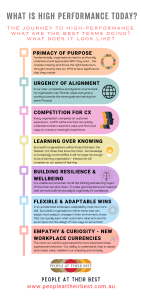Today, many organisations are talking about high-performance but we are not seeing a lot of it around, in fact, we are observing lots of undeperformance. Few teams are getting this right. We have tried to codify what we are observing in those teams that are flourishing – while there is nothing new, we do feel that this is getting harder to achieve and that the role of good leaders has never been more critical.
Click on the graphic below to magnify
In the weeks since we posted the graphic above, many clients have asked me, ‘What is the difference, what’s the secret sauce, why are so few organisations getting this right?’
Through conversations with Timothy Bristow, Sanan Thamo and Steve Klipin, I’ve come to think the ‘secret sauce’ is the leader of the team and the following 7 characteristics:
1. The leader is ‘all-in’ – leading the team is what they do and they understand that leadership is a full-time gig. Leadership cannot be part time or ad hoc and 80% of the role must be about aligning people and getting them striving to achieve the same goals
2. The team trusts the leader and feels that the leader has their back – the leader is supportive and strives to help others succeed. The leader’s focus is on helping people to be their best and letting others shine
3. The leader takes a coaching approach. Years ago, we wrote there are 6 elements that people want from their leader: Opportunity to collaborate, lots of feedback, investment in their development, guidance so that people knew where they are headed, quarantined time so that people felt valued and, a profound understanding the team’s purpose
4. The leader has genuine humility and is willing to try different things – the leader doesn’t think they have all the answers but is still willing to have a crack (and shift if something isn’t working)
5. The leader’s humility also means they don’t have to be the subject matter expert and instead, lets others shine – the leaders role is to help people shine
6. The leader understands the difference between ‘transition’ and ‘change’ and how to navigate the team’s journey through the required changes in moving to high performance
7. The leader has grit and persistence – they are in it for the long haul and determined to succeed – the leader understands that reward and satisfaction comes for the effort they put in
Many years ago we offered 15-tips to become a great leader and you can read them on our website – just serach Become a Great Leader – the final tip seems even more relevant today: “Above all, make people feel valued – ensure they know their efforts are vital to the team’s success – in doing this, you will engage people and create experiences which are cherished.”


Leave a Reply